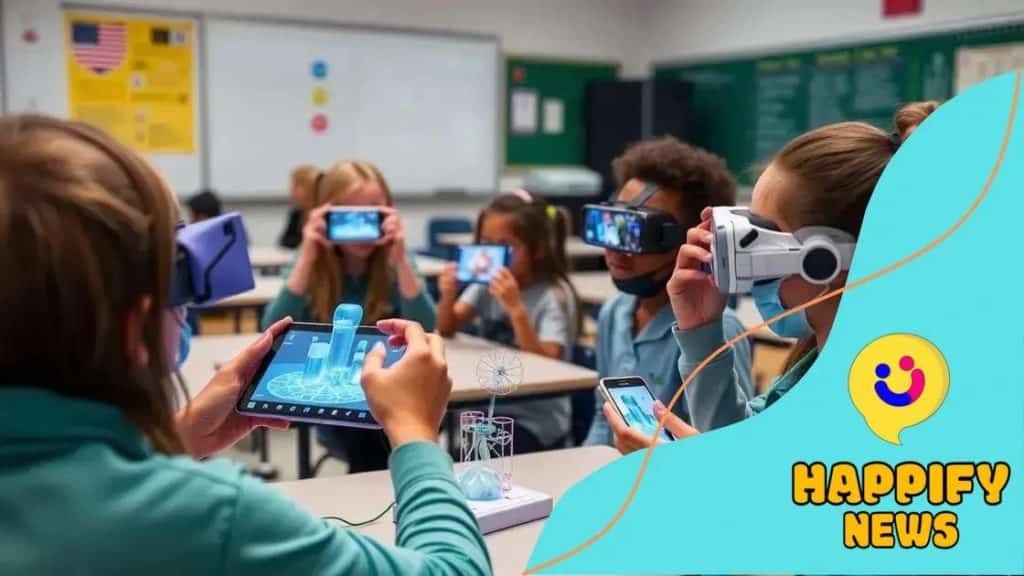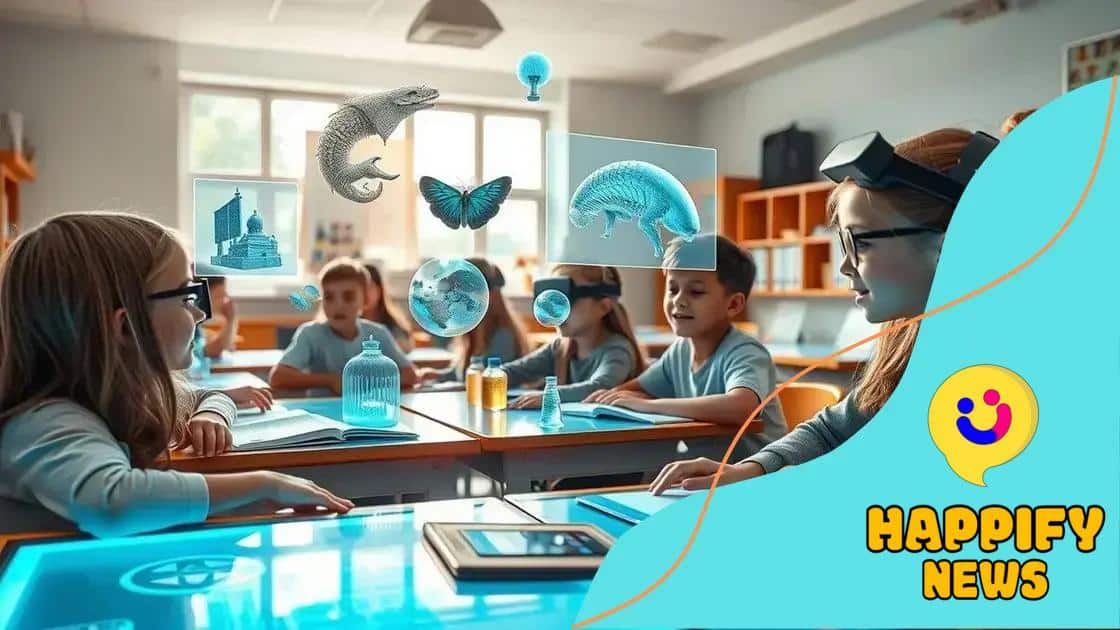AR in STEM education: transforming learning experiences

Anúncios
AR in STEM education enhances engagement through interactive experiences, personalized learning, and collaboration, while facing challenges related to cost, teacher training, and access, paving the way for a more dynamic learning environment.
AR in STEM education is creating exciting opportunities for students to dive deeper into subjects like science, technology, engineering, and math. Have you ever imagined learning geometry through a 3D hologram of shapes? Let’s explore how this technology can reshape our educational landscape.
Anúncios
Understanding AR technology in education
Understanding AR technology in education is essential for enhancing how students learn. Augmented reality (AR) combines digital information with the real world, offering interactive learning experiences. This technology allows students to explore complex topics in a way that engages their senses and curiosity.
What is Augmented Reality?
Augmented reality is a technology that overlays digital information—such as images, sounds, or other data—onto the real world. Beyond virtual reality, which immerses users in a completely digital environment, AR enhances our existing reality by adding layers of content. This means that students can visualize theoretical concepts in ways that spark interest and promote better understanding.
Benefits of AR in Education
- Interactive Learning: Students can interact with 3D models of complex structures. For instance, seeing a human heart as a 3D model can simplify anatomy lessons.
- Improved Engagement: AR captivates students’ attention, making learning fun. Engaged students are more likely to retain information and participate actively.
- Real-World Applications: Integrating AR into lessons helps students see the practical use of what they learn. This connection to the real world can inspire future careers.
- Accessibility: AR can support diverse learning styles. Visual learners benefit greatly from interactive elements, which can enhance comprehension.
As we continue to explore AR technology in education, it’s crucial to consider its limitations too. The initial cost of AR tools and devices can be high. Additionally, teachers must receive adequate training to implement this technology effectively. However, the positives often outweigh these challenges, as more schools look to invest in AR to boost educational outcomes.
Anúncios
Through AR, educators can transform traditional classrooms into dynamic learning environments. By embracing this advanced technology, we prepare students for a future where digital literacy is key, encouraging them to be creative and innovative thinkers.
How AR enhances engagement in STEM subjects
How AR enhances engagement in STEM subjects is an exciting area to explore. With augmented reality technology, students can interact with complex concepts in a more digestible way. This interactivity makes learning not only more enjoyable but also more effective.
Interactive Experiences
AR transforms traditional learning into interactive experiences. By using AR apps, students can view 3D models of scientific phenomena. For example, in a biology class, they might see a 3D model of a cell, allowing them to zoom in and explore its components. Such hands-on experiences enable students to grasp challenging material easily.
Enhanced Visual Learning
Visual aids are crucial in education. With AR, students see abstract concepts visually, making them easier to understand. Instead of merely reading from a textbook, they can view simulations, such as chemical reactions or physics experiments, in real time. This method also encourages collaborative learning, as students can discuss what they observe together.
- Collaboration: Group activities in STEM subjects benefit from AR by promoting teamwork. Students can work together on projects, leading to deeper discussions and shared insights.
- Motivation: The novelty of AR keeps students interested. When they are engaged, they participate more actively in lessons.
- Immediate Feedback: AR provides instant feedback on student performance, helping them identify areas to improve.
The engagement fostered by augmented reality is particularly vital in STEM, where subjects can often feel daunting. By bridging the gap between theory and practice, AR promotes a deeper understanding of material. Rather than just memorizing facts, students learn to apply concepts, which is essential in fields like engineering and technology.
As educators continue to integrate AR into their curricula, the benefits become clear. Students who engage with the material through augmented reality often exhibit greater enthusiasm for learning. They can explore the intricacies of STEM in a way that is both engaging and informative, paving the way for future innovations.
Practical applications of AR in the classroom

There are many practical applications of AR in the classroom that can enhance the educational experience. With augmented reality, learning becomes immersive and interactive, allowing students to explore subjects like never before. This technology can bridge the gap between theoretical knowledge and real-world applications.
Science Lessons
In science classes, AR can bring experiments to life. For example, students can use AR to visualize the solar system, exploring planets in 3D. Instead of just reading about the planets, they can see their sizes and distances, leading to a better understanding of our universe.
History Exploration
Augmented reality can transport students to historical events or locations. Imagine studying ancient civilizations and being able to walk through a virtual reconstruction of a Roman city. This immersion can increase interest and engagement in history lessons.
- Field Trips: AR can enhance field trips by providing interactive experiences at museums or historical sites. Students can scan objects to view additional information and 3D models.
- Math Learning: In math, AR can illustrate concepts like geometric shapes through 3D visualizations, helping students understand dimensions and properties more effectively.
- Language Development: Language learners can benefit from AR apps that provide translations and pronunciations through scanning objects in their environment, making learning more contextual.
Furthermore, AR can help foster creativity in areas like art and design. Students can create virtual art pieces that appear in the physical world. They can also collaborate on projects without needing to be in the same space, enhancing group work experiences.
Overall, the integration of AR technology in classrooms not only enriches the learning experience but also prepares students for a future where digital interaction is increasingly important. As educators continue to find innovative ways to use AR, students will find themselves more engaged and excited about learning.
Challenges of integrating AR in STEM education
While the benefits of augmented reality (AR) in education are clear, there are several challenges of integrating AR in STEM education that schools must consider. Understanding these challenges can help educators and administrators prepare for successful implementation.
Cost and Resources
One significant challenge is the cost associated with AR technology. Schools need to invest in hardware, software, and training. Not every school has the budget to implement AR tools effectively. Additionally, ongoing maintenance and updates can add to the cost. Without proper funding, it can be difficult to keep the technology up to date.
Teacher Training
Another barrier is the need for adequate training for teachers. Not all educators are familiar with AR tools or how to integrate them into lessons. This can lead to frustration and underutilization of the technology. Investment in professional development is crucial but often overlooked.
- Time Constraints: Teachers already face heavy workloads. Adding new technology can be daunting without enough time to plan and prepare.
- Curriculum Compatibility: Not all AR applications fit every curriculum. Educators must ensure that any AR content aligns with state standards and learning goals.
- Technical Support: AR technology requires reliable technical support in case issues arise. Without a support system, teachers may feel overwhelmed when technical difficulties occur.
Furthermore, students’ access to AR technology can vary. While some students may have access to personal devices that support AR, others may not. This disparity can create inequities in learning experiences between students. It is crucial for schools to consider how to provide equal access to all students.
The integration of AR in STEM education holds promise, but overcoming these challenges is essential for successful implementation. Schools need careful planning, collaboration, and resources to make AR a valuable part of the learning experience.
Future trends of AR in educational settings
The future trends of AR in educational settings promise to revolutionize how students learn and engage with material. As technology advances, schools are expected to incorporate more AR tools into their curricula. This evolution will enhance interactivity and engagement among students.
Increased Accessibility
One trend is the increasing accessibility of AR technologies. As smartphones and tablets become commonplace, more students will have access to AR applications. This broad availability will enable teachers to integrate AR into lessons without needing specialized equipment.
Personalized Learning
Another trend is personalized learning experiences. AR can adapt to meet the needs of individual students. For example, students can progress through lessons at their own pace, and the technology can provide tailored content based on their understanding. This customization can enhance learning outcomes and keep students motivated.
- Collaborative Learning: Future AR applications will focus on collaboration, allowing students to work together in virtual environments. They can engage in group projects, even from different locations.
- Gamification: Expect to see more gamification elements in AR applications. Adding game-like features can enhance student engagement and encourage learning through fun, rewarding experiences.
- Integration with AI: The combination of AR and artificial intelligence will lead to more intelligent educational tools. These tools will analyze student performance and adjust learning materials in real time.
Moreover, as educators gain more expertise in using AR, they will develop innovative teaching methods. Training programs will focus on helping teachers effectively implement AR and leverage its benefits. This professional development will be crucial in maximizing the educational potential of augmented reality.
Overall, the future of AR in education is bright, with numerous possibilities for enhancing learning experiences. As technology continues to advance, students can look forward to more engaging and interactive lessons that prepare them for the future.
\n
FAQ – Frequently Asked Questions about AR in Education
How does augmented reality enhance student engagement?
Augmented reality makes learning interactive and enjoyable, allowing students to visualize complex concepts and participate actively in lessons.
What are the challenges in integrating AR in classrooms?
Challenges include costs, the need for teacher training, and ensuring all students have access to the necessary technology.
What are future trends for AR in education?
Future trends include increased accessibility of AR tools, personalized learning experiences, and the integration of AR with AI for smarter educational applications.
How can teachers effectively implement AR in their lessons?
Teachers can effectively implement AR by attending professional development programs, collaborating with tech experts, and customizing AR content to align with the curriculum.






